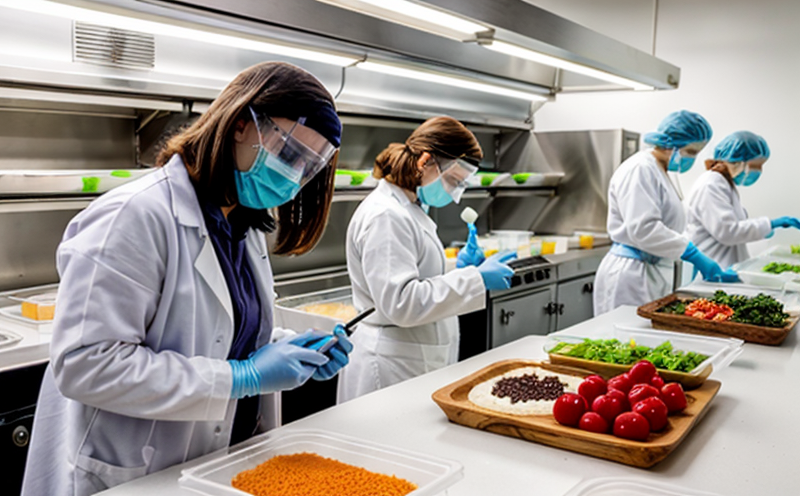ISO 16654 E. coli O157:H7 Detection Testing
The ISO 16654 standard provides a robust framework for the detection of E. coli O157:H7, a strain known for its virulence and association with severe foodborne illnesses such as hemolytic uremic syndrome (HUS). This test is critical in ensuring that food products meet regulatory standards and safeguard public health.
The E. coli O157:H7 bacterium poses a significant threat to the food industry, leading to widespread recalls and public health concerns. The ISO 16654 standard addresses this by offering a standardized method for identifying the presence of this pathogen in food products. By adhering to this protocol, laboratories can provide accurate and reliable results that are essential for maintaining consumer trust.
The detection process involves several key steps: sample collection, preparation, culture, and identification. Samples from various food matrices—such as meat, dairy, produce, and processed foods—are collected and then prepared according to the ISO 16654 guidelines. Once prepared, samples are inoculated into enrichment broths designed to enhance bacterial growth, followed by plating on selective media that allows for the isolation of E. coli O157:H7 colonies.
The standard specifies the use of XLD agar, which provides a favorable environment for E. coli O157:H7 to grow while suppressing other competing bacteria. This selective medium is critical in reducing false positives and ensuring accurate results.
Following incubation at 36°C ± 1°C for 24 hours, the colonies are then identified using biochemical tests and serological identification methods as per the ISO standard. These techniques include the use of reagents that specifically target the O157:H7 antigens present on the bacterial cell surface.
The accuracy and reliability of this testing method are paramount in ensuring food safety. By adhering strictly to the ISO 16654 protocol, laboratories can provide results that are consistent with international standards, thereby enhancing the reputation of both the laboratory and its clients.
Compliance with ISO 16654 is particularly important for quality managers, compliance officers, R&D engineers, and procurement professionals. These stakeholders rely on accurate and reliable data to make informed decisions about food safety protocols, product development, and supplier selection. The implementation of this standard ensures that all parties involved are working towards the same goal: safeguarding public health.
The ISO 16654 E. coli O157:H7 detection method has been validated through numerous studies and is widely recognized by regulatory bodies around the world. This recognition underscores its reliability and consistency, making it an essential tool for any laboratory engaged in food microbiology testing.
Scope and Methodology
| Sample Matrix | Test Procedure | Expected Results |
|---|---|---|
| Milk | Inoculate into LD broth, incubate at 36°C ± 1°C for 24 hours. | Presence of E. coli O157:H7 colonies on XLD agar after further steps. |
| Cheese | Inoculate into MRS broth, incubate at 36°C ± 1°C for 48 hours. | Confirmation using biochemical tests and serological methods. |
| Sample Matrix | Test Procedure | Expected Results |
|---|---|---|
| Cooked Meat | Inoculate into MRS broth, incubate at 36°C ± 1°C for 48 hours. | Presence of E. coli O157:H7 colonies on XLD agar after further steps. |
| Fresh Produce | Inoculate into MRS broth, incubate at 36°C ± 1°C for 48 hours. | Confirmation using biochemical tests and serological methods. |
The ISO 16654 method is designed to be versatile, accommodating various food matrices. Each matrix requires specific handling and incubation conditions to ensure accurate detection of E. coli O157:H7. The table above outlines the procedure for different sample types, highlighting the importance of proper sample preparation and culture.
The expected results from these procedures are colonies on XLD agar that exhibit characteristic morphological and biochemical traits consistent with E. coli O157:H7. Confirmation is achieved through serological identification methods, ensuring accurate differentiation from other strains of E. coli.
The ISO 16654 standard ensures consistency in testing across different laboratories by providing detailed instructions for each step. This approach minimizes variability and enhances the reliability of test results.
Why Choose This Test
The ISO 16654 E. coli O157:H7 detection method offers several advantages that make it an ideal choice for laboratories involved in food microbiology testing:
- Precision: The standard provides a detailed protocol, reducing the likelihood of errors and ensuring precision.
- Reliability: By adhering to this internationally recognized standard, laboratories can produce consistent and reliable results.
- Regulatory Compliance: Ensures that testing aligns with global regulatory requirements, enhancing compliance.
- Innovation: The method supports ongoing research and development efforts in food microbiology.
The ISO 16654 standard is particularly beneficial for laboratories serving the food industry. It allows them to provide accurate and reliable testing results that can be trusted by clients and regulatory bodies alike.
In addition, this test is crucial for maintaining consumer confidence in food safety. By detecting E. coli O157:H7 early in the production process, laboratories play a vital role in preventing contaminated products from reaching consumers.
The standard also supports continuous improvement in food safety practices by providing a benchmark against which performance can be measured and improved.
Quality and Reliability Assurance
Ensuring the quality and reliability of ISO 16654 E. coli O157:H7 detection testing is paramount for maintaining public health standards. Laboratories must adhere to strict quality assurance protocols, including:
- Calibration: Regular calibration of all instruments used in sample preparation and analysis.
- Standard Operating Procedures (SOPs): Comprehensive SOPs that outline every step of the testing process.
- Laboratory Accreditation: Certification from a recognized accreditation body, ensuring adherence to international standards.
- Data Validation: Regular validation of test data against known reference strains and previously validated results.
The use of certified reagents and culture media is essential for maintaining the accuracy of test results. Laboratories must also maintain strict quality control measures, including regular internal audits and external proficiency testing programs.
By implementing these quality assurance practices, laboratories can ensure that their ISO 16654 E. coli O157:H7 detection tests are reliable and consistent. This reliability is critical for maintaining trust in the food industry and ensuring public health safety.





